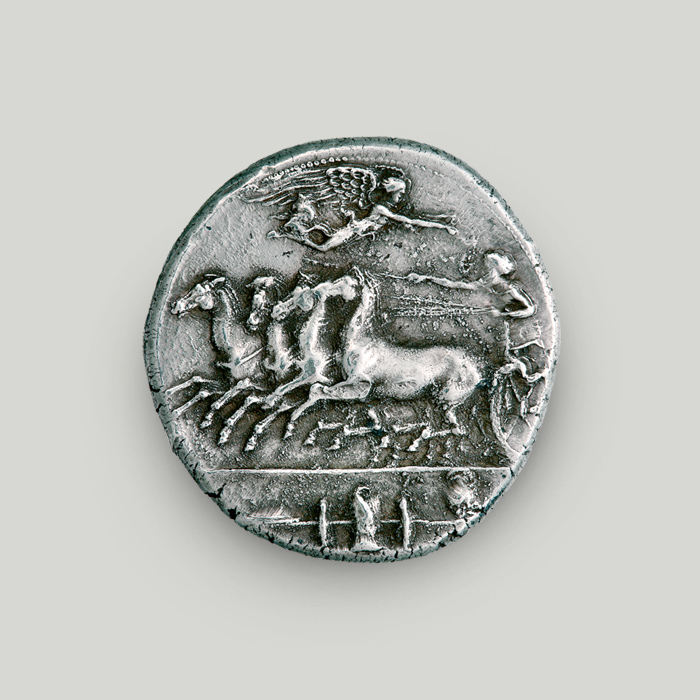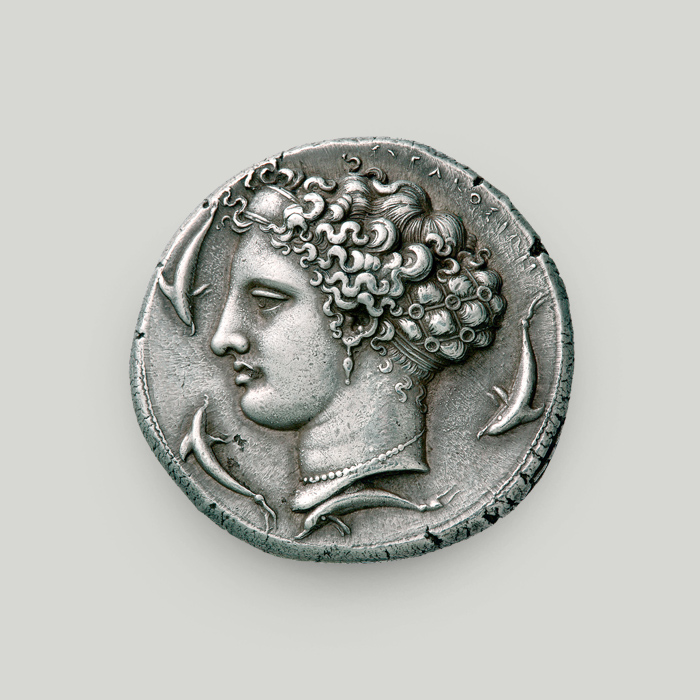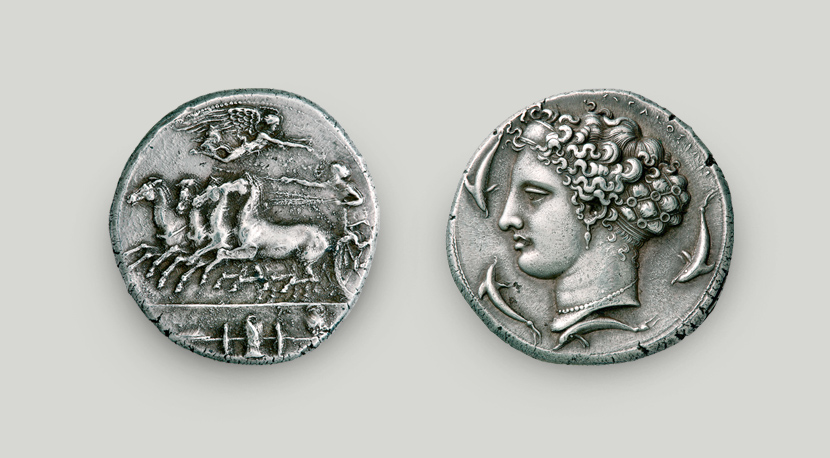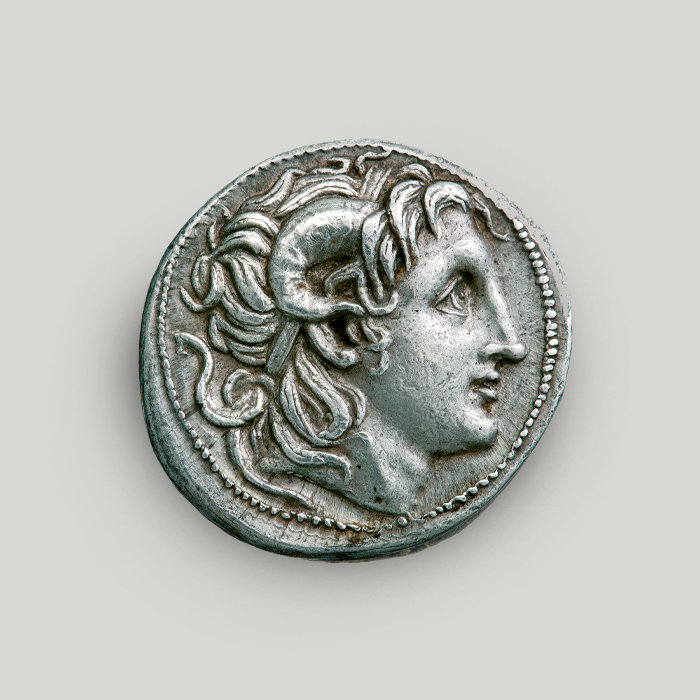Silver decadrachm, Syracuse, Sicily
The silver decadrachm of Syracuse, Sicily, is a true masterpiece of Classical numismatics. Syracuse minted more coins than any other Sicilian city, boasting one of the most impressive minting practices in the ancient world. The type is inspired by myth and the social life of the city. The decadrachm in the Numismatic Collection is the unsigned work of Syracusan die-engraver Kimon.
Obverse
Charioteer driving a tethrippon (4-horse chariot). Above him, a crowning Nike probably signifies his victory at an event. The exergue (segment under the main design) depicts an armour and weapons.
Reverse
Head of the nymph Arethusa with 4 dolphins swimming around it. The nymph wears earrings, a headband, and her hair in a crobylus (a roll of hair on the crown of the head). The legend at the top right reads ΣΥΡΑΚΟΣΙΩΝ (of the Syracusans).
The most splendid city in Sicily
During the Greek Colonisation, the Delphic Oracle told the Corinthians to build a colony on the island of Ortygia in Sicily. Archias was to be the oikistes, i.e. the leader of the colonisation effort. The city of Syracuse was founded in 743/733 BCE.
According to ancient historian Thucydides, the colonists’ priority was to drive the native population to the mainland and have the entire island to themselves.
Soon, the city expanded into the neighbouring coast. In the words of the Roman orator and politician Cicero, Syracuse became “the wealthiest and most splendid city in Sicily.”
For many centuries, this Corinthian colony had a key role in the political and military history of the Ancient Greek world.
Syracuse on the verge of war
Dionysius I became tyrant of Syracuse in 405 BCE and started preparations to wage a war against Carthage.
The merchants and tradesmen who swarmed into the city were hired as mercenaries. Ships were built, along with weapons and war machines. This is when the stone-hurling catapult was invented.
Building activity took off, including the construction of protective walling.
Coins issued to cover military needs
Dionysius I needed income and precious metals to issue enough coinage and meet the needs of his army. These derived from taxes imposed on the citizens, seized estates, looting and from the wealth of the cities Dionysius destroyed.
The decadrachms were issued in this very context. Syracuse minted these coins around 400 BCE. The value of this denomination was quite high.
Masterpieces of numismatic art
Syracuse minted more coins than any other Sicilian city, boasting some of the most impressive coinage in the ancient world.
The famous Syracusan decadrachms deserve a place among the major masterpieces of Classical numismatic art. They are every ancient coin collector’s dream, and with good reason.
The silver decadrachm of Syracuse, Sicily, included in the Numismatic Collection is the unsigned work of die-engraver Kimon.
The nymph Arethusa
The type on the obverse is inspired by the founding myth of Syracuse. It depicts Arethusa, a spring and forest nymph, daughter of Nereus and Doris and an attendant of the goddess Artemis.
The river god Alpheus, which flowed in the Peloponnese between the regions of Elis and Arcadia, fell in love with Arethusa. The nymph crossed the sea between the Peloponnese and Sicily. When she reached Ortygia, an isle off the coast of Sicily, Artemis transformed her into a gurgling spring of crystal-clear water.
In turn, Alpheus transformed himself into a powerful undersea current. Not even the Adriatic Sea was able to interrupt his violent flow. He crossed the same sea Arethusa had crossed to thwart his advances. In the end, Alpheus reached Sicily to join his waters with those of Arethusa, now turned into a spring.
The beautiful nymph, ever surrounded by swimming dolphins, will always stay as a reminder of Syracuse’s Peloponnesian origins.
The chariot races
The type on the reverse is inspired by social life in Syracuse. The tethrippon (4-horse chariot) reflects the local nobility’s love of chariot races.
Fractions and etymology
As suggested by its name, the decadrachm equalled 10 drachmas. Each drachma equalled 6 obols.
Before the invention of coins, people used iron spits of 1-1.5 meters in length for their daily transactions.
The spits was called ovelos, and 6 of them were considered a standard handful. This handful was later dubbed “drachma”, as it could be grasped (drattomai in Ancient Greek) in a person’s fist.
When coins started to circulate, the word ovelos (the previously used spits) changed to ovolos (“obol” in modern numismatics) and was used to denote the value once held by 1 spits, i.e. 1/6 of a drachma.
The coin in our publications
The Syracusan silver decadrachm is mentioned in the book The Europe of Greece: Colonies and Coins from the Alpha Bank Collection, edited by Dr Dimitra Tsangari. The publication presents the Second Greek Colonisation mainly through the coins of the Alpha Bank Collection, but also through other artefacts and material.
Buy the publication The Europe of Greece: Colonies and Coins from the Alpha Bank Collection on the Alpha Bank e-shop.
The Alpha Bank Numismatic Collection is not open to the public.
Research visits to the Numismatic Collection can be organised upon request.
Contact us to book your visit.








